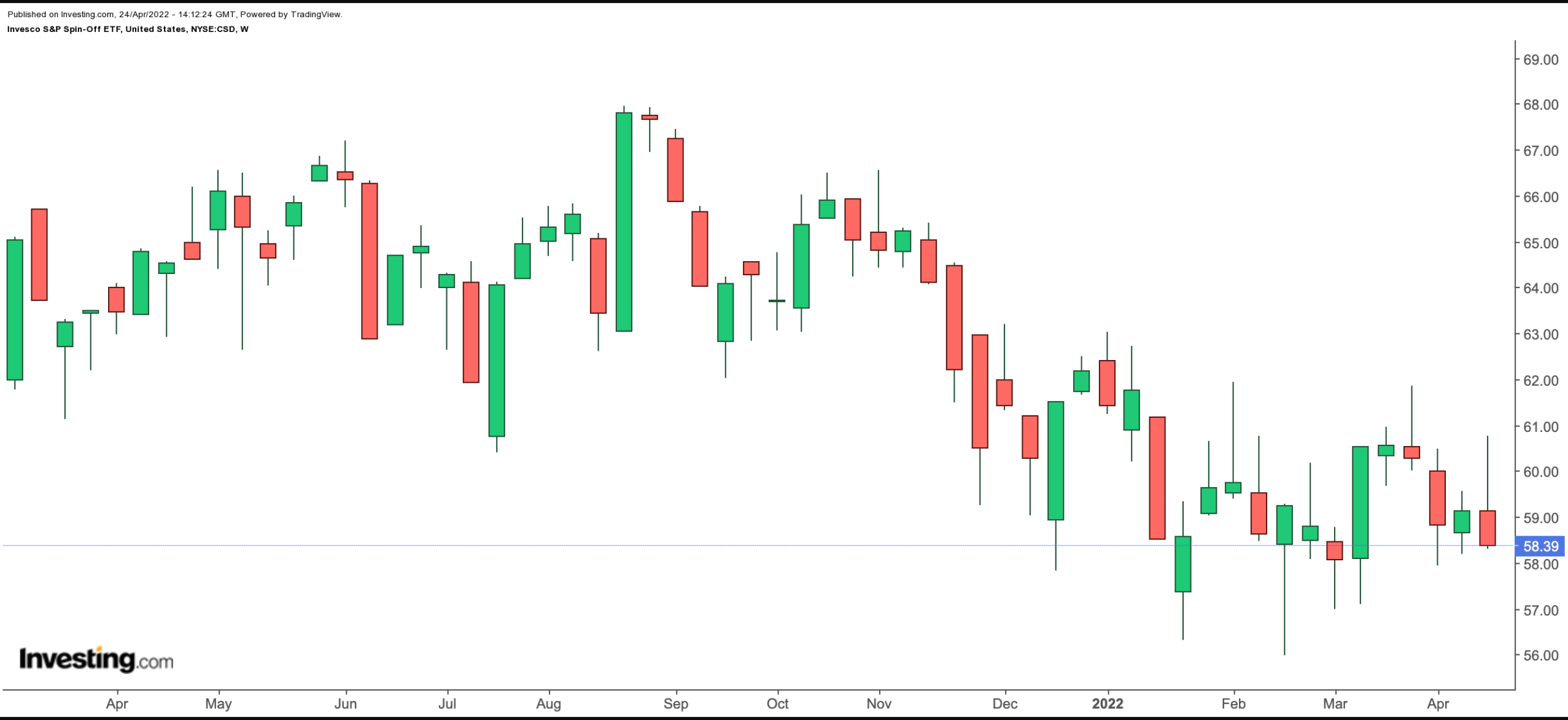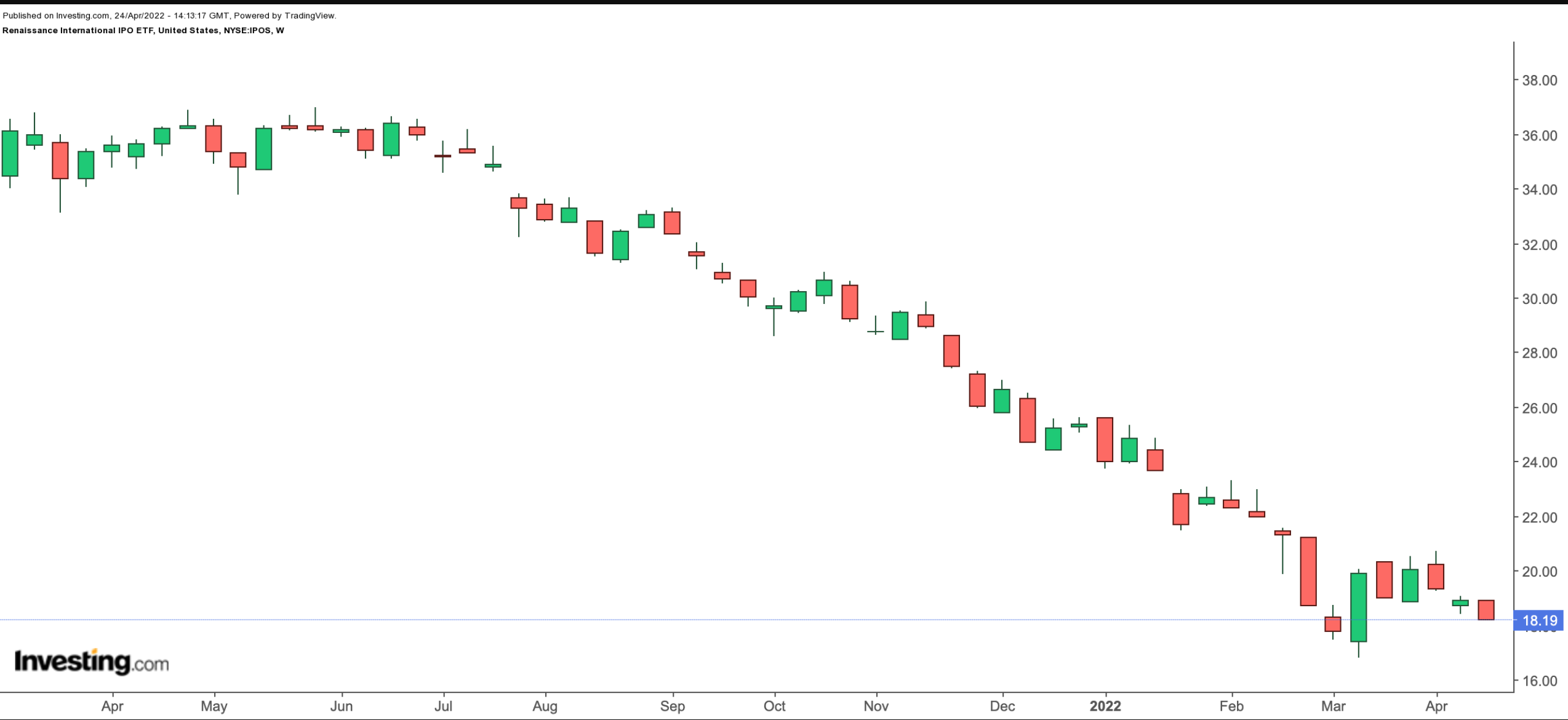Broader markets have been volatile since the start of 2022. The first quarter of the year— as well as the month of April thus far—has been brutal for many high-growth tech companies, aka “pandemic darlings.”
Nevertheless, despite the sell-off on Wall Street, companies that go public still get plenty of attention. Today’s article, therefore, introduces two exchange-traded funds (ETFs) for investors who want to invest in newly publicly traded stocks.
1. Invesco S&P Spin-Off ETF
- Current Price: $58.39
- 52-week range: $55.99–$67.97
- Dividend yield: 0.78%
- Expense ratio: 0.65% per year
In a corporate spin-off, companies turn a subsidiary or segment into an independent separate business by issuing shares in the new entity. Research by McKinsey suggests:
“…ParentCo can separate from SpinCo in a way that creates value for both… Indeed, our empirical research suggests that spin-offs outperform by supporting the long-term growth and value-creation opportunities of both entities.”
Communications services giant AT&T (NYSE:T) recently finalized the WarnerMedia spin-off which we recently covered. Its media segment then merged with Discovery and became Warner Bros Discovery (NASDAQ:WBD). Wall Street has been positive on the future of both WBD and T shares.
Our first fund, the Invesco S&P Spin-Off ETF (NYSE:CSD) gives access to businesses that have been spun off from their parent companies within the past four years. The fund start trading in December 2006.

CSD, which tracks the S&P US Spin-Off Index, currently has 31 holdings. In terms of sub-sectors, we see industrials (31.24%), materials (15.82%), consumer discretionary (13.67%), information technology, IT (9.17), energy (8.64) and utilities (7.87%), among others.
The top 10 stocks in the portfolio comprise over 60% of $67.1 million in net assets. In other words, CSD is a relatively small, but highly concentrated fund.
Constellation Energy (NASDAQ:CEG), chemical giant Dow (NYSE:DOW), agriculture mega cap Corteva (NYSE:CTVA), industrial machinery maker Otis Worldwide (NYSE:OTIS), HVAC provider Carrier Global (NYSE:CARR), Wyndham Hotels & Resorts (NYSE:WH) and Apartment Income REIT (NYSE:AIRC) are among the leading names.
CSD hit a record high in August 2021. But the ETF is down to 6.1% year-to-date. By comparison, the S&P 500 Index has declined 10.3%.
Forward P/E and P/B ratios for CSD stand at 16.66x and 3.34x. We believe the spin-off strategy deserves readers’ attention.
2. Renaissance International IPO ETF
- Current Price: $18.19
- 52-week range: $16.81–$37.00
- Expense ratio: 0.80% per year
From spin-offs, we move on initial public offerings (IPOs). According to PwC, 2021 was a record year when 2,682 global IPOs raised “$608bn, including 459 IPOs in EMEA raising $99bn.”
But 2022 is proving to be a different story. In the first quarter, “global IPO volumes fell 37%, with proceeds down by 51% year-on-year (YOY).”
Yet, despite the decline in the number of transactions, Wall Street is still watching IPO stocks, which can be among the most explosive shares to hold in growth portfolios.
Our next fund, the Renaissance International IPO ETF (NYSE:IPOS) invests in liquid, newly listed stocks outside the US. The ETF, which is rebalanced quarterly, has been trading since October 2014.

IPOS, which tracks the Renaissance International IPO Index, currently has 71 holdings. Around 20% of the portfolio is held in financials. Next come technology services, consumer durables, consumer non-durables and retail trade.
The top 10 stocks in the portfolio account for close to 46% of $11.3 million in net assets. Chinese names have the highest slice with 43.1%. Other countries include Sweden (20.4%), the UK (8.5%), Thailand (5.0%), the Netherlands (4.4%) and Canada (3.9%).
Leading holdings in the portfolio include Sweden-based automaker Volvo (ST:VOLVb) and private equity group EQT (NYSE:EQT), Chinese social platform operator Kuaishou Technology (HK:1024); Chinese beverage name Nongfu Spring (HK:9633); and ESR Cayman (HK:1821), which manages logistics assets.
IPOS is down 28% since January and 49.1% in the past 52 weeks. We also have to remind readers that over the past year, Chinese stocks have come under significant pressure.
For instance, so far in 2022, the Shenzhen Composite index and the Shanghai Composite index have declined 24.3% and 15.2%. Those readers who want to allocate a small portion of their portfolios to newly listed shares outside the US may want to research IPOS further.
On a final note, the Renaissance IPO ETF (NYSE:IPO) invests in US companies that have gone public recently. Year-to-date, IPO is down 36.5%.
